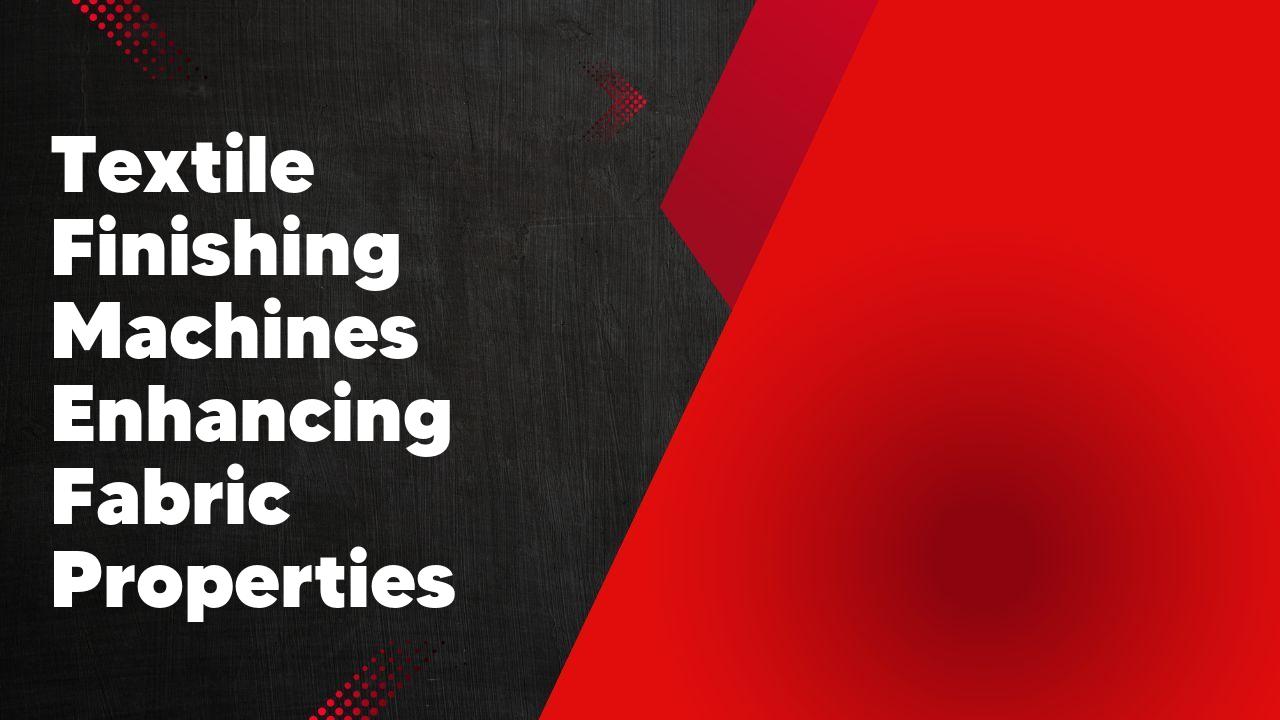Textile finishing machines play a crucial role in enhancing the properties of fabrics. These machines are designed to add various finishes to fabrics, such as softness, durability, water resistance, and wrinkle resistance. With the advancements in technology, textile finishing machines have become more efficient and effective in achieving desired fabric properties.
Introduction to Textile Finishing Machines
Textile finishing machines play a crucial role in the textile industry by enhancing the appearance, durability, and functionality of fabrics. These machines are used to apply various finishes to textiles, such as dyeing, printing, coating, and laminating. They are designed to handle different types of fabrics, including cotton, silk, wool, and synthetic fibers. Textile finishing machines utilize advanced technologies and processes to ensure precise and efficient application of finishes. They can be operated manually or automatically, depending on the complexity of the finishing process. With the increasing demand for high-quality and innovative textiles, the textile finishing machine market is expected to witness significant growth in the coming years.
The Role of Textile Finishing Machines in Enhancing Fabric Properties

Textile finishing machines play a crucial role in enhancing the properties of fabrics. These machines are designed to apply various treatments and finishes to the fabric, resulting in improved performance and aesthetics. One of the key benefits of textile finishing machines is their ability to enhance the durability and strength of fabrics. Through processes such as heat setting and calendaring, these machines can increase the fabric’s resistance to wear and tear, making it more long-lasting. Additionally, textile finishing machines can also improve the fabric’s appearance by adding finishes such as softeners, water repellents, and flame retardants. Overall, these machines are essential in ensuring that fabrics meet the desired quality standards and perform optimally in various applications.
Types of Textile Finishing Machines
Textile finishing machines are essential in the textile industry as they help enhance the appearance, durability, and functionality of fabrics. There are various types of textile finishing machines available, each serving a specific purpose. One common type is the stenter machine, which is used to stretch and dry fabrics, ensuring they maintain their desired width and shape. Another type is the calender machine, which applies pressure and heat to fabrics, resulting in a smooth and glossy finish. Additionally, there are machines like the mercerizing machine, which treats fabrics with caustic soda to improve their strength and luster. Overall, these machines play a crucial role in the production of high-quality textiles.
Key Features and Functions of Textile Finishing Machines
Textile finishing machines play a crucial role in the textile industry by enhancing the quality and appearance of fabrics. These machines are equipped with various key features and functions that contribute to their effectiveness. One important feature is the ability to apply different types of finishes to fabrics, such as water repellency, flame resistance, and wrinkle resistance. Additionally, these machines can perform processes like dyeing, printing, and coating, allowing for a wide range of customization options. They also have advanced control systems that ensure precise and consistent application of finishes. Overall, textile finishing machines are essential for achieving desired fabric properties and meeting customer demands in the textile industry.
Benefits of Using Textile Finishing Machines in the Textile Industry
Textile finishing machines play a crucial role in the textile industry, offering numerous benefits to manufacturers. Firstly, these machines enhance the quality of the finished textile products by improving their appearance, texture, and durability. They can apply various finishes such as waterproofing, flame retardant, and anti-static treatments, making the textiles more functional and marketable. Additionally, textile finishing machines increase production efficiency by automating processes that would otherwise be time-consuming and labor-intensive. This not only reduces costs but also ensures consistent and uniform results. Moreover, these machines contribute to sustainability efforts by reducing water and energy consumption during the finishing process. Overall, the use of textile finishing machines is essential for manufacturers to stay competitive in the industry and meet the demands of consumers.
Future Trends in Textile Finishing Machines
Textile finishing machines play a crucial role in the textile industry, as they are responsible for enhancing the appearance, performance, and durability of fabrics. As technology continues to advance, the future of textile finishing machines looks promising. One of the key trends in this industry is the integration of automation and artificial intelligence (AI) into these machines. This allows for more efficient and precise finishing processes, reducing the need for manual labor and increasing productivity. Additionally, there is a growing focus on sustainability in the textile industry, and this is reflected in the development of eco-friendly finishing machines that use less water, energy, and chemicals. Overall, the future of textile finishing machines is set to revolutionize the industry, making it more efficient, sustainable, and technologically advanced.
Conclusion
In conclusion, textile finishing machines play a crucial role in enhancing the properties of fabrics. These machines offer a wide range of capabilities, from improving the durability and strength of fabrics to adding special finishes such as water repellency or flame resistance. With advancements in technology, textile finishing machines continue to evolve and provide innovative solutions for the textile industry.
What are textile finishing machines?
Textile finishing machines are equipment used in the textile industry to enhance the properties of fabrics. These machines are designed to apply various treatments and processes to fabrics, such as dyeing, printing, coating, and finishing.
What is the purpose of textile finishing?
The purpose of textile finishing is to improve the appearance, performance, and functionality of fabrics. It involves applying different treatments to fabrics to enhance their properties, such as making them more durable, water-resistant, flame-retardant, or wrinkle-free.
What types of treatments can textile finishing machines apply?
Textile finishing machines can apply a wide range of treatments to fabrics, including dyeing, printing, coating, and finishing. Dyeing involves coloring the fabric, while printing adds patterns or designs. Coating can provide fabrics with additional functionalities, such as water repellency or flame resistance. Finishing treatments can improve the fabric’s texture, softness, or wrinkle resistance.
How do textile finishing machines work?
Textile finishing machines work by applying the desired treatment to the fabric. This can be done through various methods, such as immersion, padding, spraying, or drying. The machines are equipped with specialized mechanisms and controls to ensure precise application of the treatment and to achieve the desired results.
What are the benefits of using textile finishing machines?
Using textile finishing machines offers several benefits. It allows textile manufacturers to enhance the properties of fabrics, making them more appealing to consumers. It also enables the production of fabrics with specific functionalities, such as moisture-wicking or stain resistance. Additionally, textile finishing machines can improve the efficiency and productivity of textile production processes.
Are textile finishing machines suitable for all types of fabrics?
Textile finishing machines can be used on a wide range of fabrics, including natural fibers like cotton, silk, and wool, as well as synthetic fibers like polyester and nylon. However, the suitability of a particular machine for a specific fabric depends on factors such as the fabric’s composition, structure, and desired treatment. It is important to consult the machine manufacturer or a textile expert to determine the compatibility of a machine with a particular fabric.

